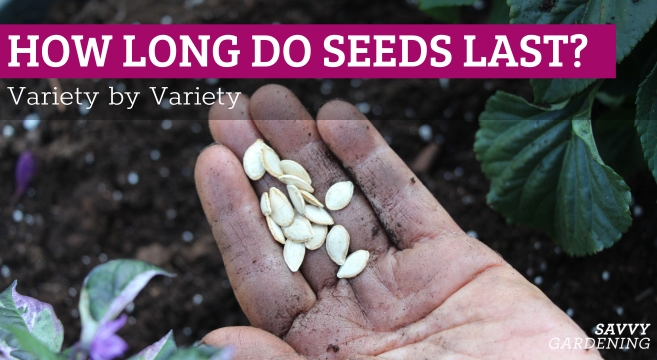This post may contain affiliate links. If you make a purchase through links on our site, we may earn a commission.
In other articles, we’ve offered great tips for collecting seeds, saving seeds, sowing seeds, and even ordering seeds. But, if the question “how long do seeds last?” is on your mind, this article will offer you some answers.
Before I look at a single seed catalog, I take inventory of all the seeds I already have on hand, sorting them first by age. All seed packets are stamped with the year they were packed. This date is important because many seeds loose viability as they age. If you want to plant only seeds that will have exceptional germination rates, you’ll need to know how many years each variety can be stored. As I sort through my box of seed packets from previous years, I pitch any that are past their prime. Here’s the basic roadmap I use when sorting through all those leftover seed packets.
Seed life spans
The seed life spans listed below are only a guideline. Some seeds may last much longer than these times, however their germination rates will slowly decrease over time. Other seeds won’t remain viable for as long as they should, especially if they were exposed to moisture or extreme conditions. The amount of time seed remains viable depends on many factors. Quality seed suppliers package and sell new, fresh seed each year, but the independent seed purveyors you sometimes see on Etsy, Amazon, and other websites are not regulated and may be selling old or mislabeled seed. Seed packets should be clearly stamped with the date of packaging and the seller should note in their catalog or on their website when their seed was harvested (ideally at the end of the previous growing season). Quality sources are key.
How long do seeds last? A helpful list
Seeds that remain viable for up to 5 years:
- Most annual and perennial flowers
- Artichokes
- Cucumbers
- Watermelons, muskmelons, and cantaloupes
- Radish
Up to 4 years:
- Tomatoes
- Eggplant
- Summer squash
- Winter squash
- Pumpkins and gourds
- Beets
- Chard
- Turnips
Up to 3 years:
- Beans
- Peas
- Cabbage
- Cauliflower
- Broccoli
- Brussel’s sprouts
- Carrots
Up to 2 years:
- Corn
- Okra
- Peppers
- Spinach
Up to 1 year:
- Lettuce
- Onion

Checking germination rates
If you’re not sure how old a seed is, either because the packet isn’t dated or because you’ve stored them in another type of unmarked container, test their viability before planting. Place ten seeds on a damp paper towel. Fold the paper towel over the seeds and put in a plastic, zipper-top baggie. Place the baggie on top of the fridge, and in ten days, open the paper towel and count how many seeds have germinated. This is the germination rate. If less than six seeds germinated (a rate below 60%), the seeds may not be worth planting. But, if more than six seeds sprouted, go ahead and use the seeds.
Storing seeds properly
Storing seeds under the correct conditions prolongs the life of the seeds and often extends their life. This extensive article on our site offers tips for proper seed storage.
More advice on handling seeds
- Seed catalog choices
- The winter seed sowing method
- Advice on how to direct seed
- Saving seeds from dill
- Easiest flowers to grow from seed





An interesting note, although I think from past experience I would rearrange several things on your list….carrots really don’t seem to perform well after the first year, peppers on the other hand might get to four as will tomatoes. I have never had very good luck with cukes/squash that were at all “aged”, same with spinach. I would also never generalize with perennial seeds….they are such a mixed bag that it is impossible to make assumptions. While some might have more than a year’s life, many will barely make it through dry storage for one planting season.
Parsnips , barely one year.
Storing dry seeds in tightly sealed jars in the deep freeze can increase viability of many seeds by years.
I’m going to disagree with the commenter who said that carrot seeds don’t last that long. I dumped a bunch of old seeds dated from 2008 in a big planter earlier this year and I’ve got carrot plants growing like weeds and tiny carrots burrowing into the soil.
I found an envelope of Hollyhock seeds in my grandma’s desk, marked with the 5th year previous, so I planted some the next spring. Nothing came up. However the next spring they all came up and a gorgeous purple!!!
My rule is “don’t bet the harvest” on old seed, but DO plant them”; you may just get a surprise!
Best Comment of all.
My vote is that article’s “up to” should be interpreted as “avg.” For sure Brenda! And to refine the concept, maybe sew those old ones a wk or 2 early, and if don’t sprout as typical then use new ones even a wk or 2 later than would have otherwise. Worth the effort.
Freezing was mentioned in comments (and critical for those requiring stratification), but so much more should have been article. Seeds should be stored cool and dry. I store in tins with tight lids and add silica packs rcvd with supplements, etc. Some are stored in refrig which assume significantly prolongs viability. Storage matters a lot – just as with seafood!
I’ve had tomato had seeds sprout that were over 20 years old and several big moves later.